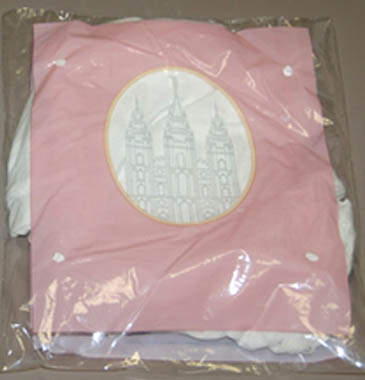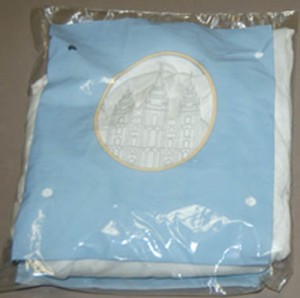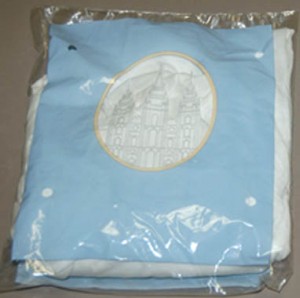A Response to “LDS Garments and Agency”
HEADER
by Laura Morlock, PhD
HEADER
The dressed body mediates between the inner self and the surrounding world. It establishes our identities in social spaces where these can be uncertain and acts as a symbol through which we are read and can read others (however ambiguous these readings may be). Dress may be commonplace, but it is far from vacuous or insignificant. It acts as the visible embodiment of our intentions. Our clothes help us to be at home within ourselves and within our communities. Dress standards make our bodies respectable, appropriate, and acceptable within particular contexts, where individuals develop a “feel” for what to do, interpreting (both consciously and unconsciously) the rules and, at times, improvising around them. However, dress transgressions often result in swift group censure. Social pressures encourage us to remain within the boundaries of what those around us consider “normal” and “appropriate” presentation, thereby managing identity through dress. Making such errors is not merely an embarrassing social faux pas but causes the shame of failing to meet required moral standards of the social space. Because dress both touches our bodies and faces outward toward others, it encapsulates and enables both individual and collective identities. Yet, when these two collide (intentionally or not), dress can quickly become a flashpoint for conflicting community values and internal identities. Dress, then, has strong social and moral dimensions that constrain the clothing choices people make. We, all of us, read dress to determine whether a person is worthy of our respect. The uncodified rules that determine what is appropriate for individuals to wear in a given place are almost as rigid as rules of law. Dress gives the body social meaning, while the body gives life to dress.

Garments for women 
Garments for men
HEADER
This is where Nancy Ross’ work on Latter-Day Saints’ (LDS) garments comes into play, and the ways inner ideals of commitment to a covenant with God and the LDS Temple (and the dressed lifestyle that entails) can conflict for some with the functions and realities of women’s bodies. Temple garments have often been a source of fascination for non-LDS members. Though discussing them publicly is generally considered taboo, Ross felt it was important to look deeper into women’s relationships with their garments. Many LDS women experience wearing them as a beautiful practice that connects them to the Temple, God, and their community. For these individuals, the embodied sensation of their garments against their skin grounds them in their spiritual practice and personal identity as LDS women. Ross explains how receiving her garments made her feel like a full adult member of her community for the first time.
HEADER
For many women, however (including Ross), their garments either cause or exacerbate medical conditions and cause practical challenges for functions specific to the female body such as menstruation, breastfeeding, and pregnancy. Joanne Entwistle (2000, 2012) is renowned for arguing that phenomenology enables studying dress as material culture that is a situated bodily practice. She bridges the gap between theories of the body (which tend to overlook dress) and theories of dress (which tend to ignore the body), arguing that this gap results in a complete oversight of the “dressed body” as a phenomenological field. Ross’ discussion of the ways LDS garments create embodied challenges that manifest in spiritual friction is an excellent example of Entwistle’s ideas. Our clothes do not simply shield our concepts of modesty or protect us from the elements, nor do they just reflect the physical body. Dress embellishes, adding a host of meanings to our physical presentation that would otherwise be absent. Dress is a fundamental link between our identity and our bodies. Therefore, when items that act as sacred practice create problems with a woman’s body, this can challenge the very centre of their identity as LDS women.
HEADER
Dress plays an essential role in the presentation of the body and self, but how the body is experienced and lived in everyday life shapes a person’s relationship with dress. If, as Ross illustrates, garments lead to yeast infections or inhibit breastfeeding, women who previously appreciated the practice may naturally grow to resent it. If, as Ross reports, their husbands find their garments deaden sexual interest, then there is a tension between their very gendered identities as wives and mothers and the counterproductive realities of garments that are supposed to be inherently feminine.
HEADER
An inability for these women to modify their garments exacerbates these tensions. Religious dress is an area where it is usually easy to find women acting on religion and in religious ways, but members of the LDS church are expected to wear their garments as they receive them. Ross describes how “technically,” personal interpretation between the self and God is allowed, and therefore there should be space for adaptation (such as around a cesarean incision), but in reality there is not much allowance for physical challenges. She connects this to other LDS taboos around the body, which in turn affects how they approach garments. In fact, the very act of discussing garments is transgressive, as many feel it is simply too sacred to discuss. However, a “don’t talk about it” approach makes experimentation and adaptation very difficult. As a result, very few women feel free to modify their garments, and so physical issues can become spiritual issues. Since connection to God is so embedded in the communal understanding of garments, problems with them can lead to feeling separated from God, and resentments toward them can lead to resentments toward God and the church for requiring them. While garments are particular to the LDS church, this strain between required religious dress and resultant dissatisfaction with the community that requires it certainly is not. This is particularly true for women within conservative religious communities, such as some sects of Mennonites and debates over prayer bonnets (Arthur 1997).
HEADER
As within many other religiously conservative communities, monitoring this dress practice serves group boundary maintenance well. Ross notes that garment lines — especially women’s garment lines — are quite visible and are expected within the community. Therefore, if a woman is not wearing her garments any other LDS member will know and will likely conclude that “something is wrong.” Since the garments represent a covenant, it is possible she has broken her vows or that she is not wearing them as a result of church leadership censure. Conversely, seeing the garment lines symbolizes all is well with the in-group. As a result, many women feel compelled to wear their garments in the way their community expects of them, with little agency to modify the practice to suit physical discomfort.
ADER
Garments as boundary maintenance function in a particularly gendered way. Ross explains how men designed the garments, and women do not have a say in their construction. As a result, they were created without women’s sexualized bodies in mind, but LDS women have no way to functionally modify the design while staying within acceptable LDS social and spiritual boundaries. Since Latter-day Saints believe that gender is eternal, that garments (which are gendered) are tied to a person’s salvation, and that not wearing them is spiritually dangerous, many LDS women feel deeply constrained. They are unable to modify the practice to suit their embodied needs, and they are unable to continue the practice in its current form. There is no satisfactory solution. At the same time, the LDS community seems aware of many women’s discontent and is taking steps to improve women’s garments. /I would be interested to know Nancy Ross’ thoughts on these changes, and whether they are a significant improvement to the problems she brings to light.
HEADER
Ross’ work on LDS garments highlights the complexity of meanings within dress and the ways bodies can communicate social and religious values. They act as non-verbal communication to the larger LDS community and literally materialize gender on the body. Research into modest religious dress often reveals women as active agents in their own sacred practice pathways (such as from Reina Lewis, Leila Ahmed, Linda B. Arthur, or Liz Bucar), far from the passive victims of patriarchal religion of popular imagination. While LDS garments act as both boundary maintenance and embodied spiritual customs in the same way as many other examples of conservative religious dress, the particularities of these male-designed clothes that create physical difficulties but cannot be changed adds a different and important dynamic that certainly deserves further attention.
HEADER
REFERENCES
HEADER
Ahmed, Leila. A Quiet Revolution: The Veil’s Resurgence, From the Middle East to America. Yale University Press, 2011.
HEADER
Arthur, Linda B. “‘Clothing is a Window to the Soul’: The Social Control of Women in a Haldeman Mennonite Community.” Journal of Mennonite Studies 15 (1997): 13-17.
HEADER
Bucar, Liz. Pious Fashion: How Muslim Women Dress. Harvard University Press, 2017.
HEAHEADER
Craik, Jennifer. The Face of Fashion: Cultural Studies in Fashion. London: Routledge, 1994.
HEADER
Entwistle, Joanne. “Fashion and the Fleshy Body: Dress as Embodied Practice,” in Fashion Theory, 4 no. 3 (2000): 323-347.
HEADER
Lewis, Reina ed. Modest Fashion: Styling Bodies, Mediating Faith, (London: I.B. Tauris, 2013).
HEADER
McDannell, Colleen. Material Christianity: Religion and Popular Culture in America. New Haven: Yale University Press, 1995.
HEADER
Morlock, Laura. “How it Seams: Religious Dress, Multiculturalism, and Identity Performance in Canadian Society, 1910-2017.” PhD diss., University of Waterloo (2018). UWSpace. http://hdl.handle.net/10012/13298.



